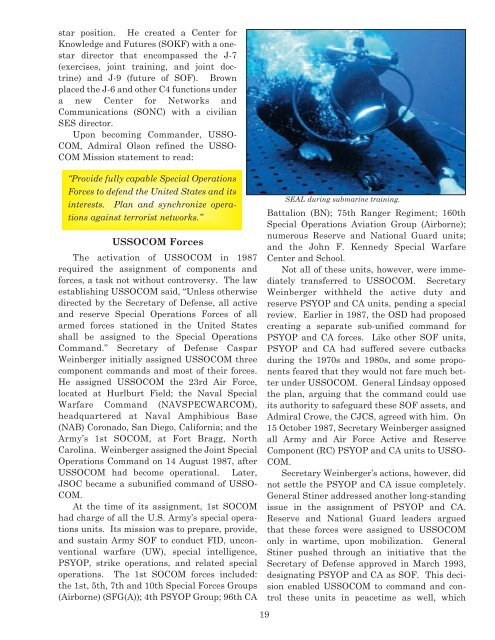HQ$History - United States Special Operations Command
HQ$History - United States Special Operations Command
HQ$History - United States Special Operations Command
You also want an ePaper? Increase the reach of your titles
YUMPU automatically turns print PDFs into web optimized ePapers that Google loves.
star position. He created a Center for<br />
Knowledge and Futures (SOKF) with a onestar<br />
director that encompassed the J-7<br />
(exercises, joint training, and joint doctrine)<br />
and J-9 (future of SOF). Brown<br />
placed the J-6 and other C4 functions under<br />
a new Center for Networks and<br />
Communications (SONC) with a civilian<br />
SES director.<br />
Upon becoming <strong>Command</strong>er, USSO-<br />
COM, Admiral Olson refined the USSO-<br />
COM Mission statement to read:<br />
“Provide fully capable <strong>Special</strong> <strong>Operations</strong><br />
Forces to defend the <strong>United</strong> <strong>States</strong> and its<br />
interests. Plan and synchronize operations<br />
against terrorist networks.”<br />
USSOCOM Forces<br />
The activation of USSOCOM in 1987<br />
required the assignment of components and<br />
forces, a task not without controversy. The law<br />
establishing USSOCOM said, “Unless otherwise<br />
directed by the Secretary of Defense, all active<br />
and reserve <strong>Special</strong> <strong>Operations</strong> Forces of all<br />
armed forces stationed in the <strong>United</strong> <strong>States</strong><br />
shall be assigned to the <strong>Special</strong> <strong>Operations</strong><br />
<strong>Command</strong>.” Secretary of Defense Caspar<br />
Weinberger initially assigned USSOCOM three<br />
component commands and most of their forces.<br />
He assigned USSOCOM the 23rd Air Force,<br />
located at Hurlburt Field; the Naval <strong>Special</strong><br />
Warfare <strong>Command</strong> (NAVSPECWARCOM),<br />
headquartered at Naval Amphibious Base<br />
(NAB) Coronado, San Diego, California; and the<br />
Army’s 1st SOCOM, at Fort Bragg, North<br />
Carolina. Weinberger assigned the Joint <strong>Special</strong><br />
<strong>Operations</strong> <strong>Command</strong> on 14 August 1987, after<br />
USSOCOM had become operational. Later,<br />
JSOC became a subunified command of USSO-<br />
COM.<br />
At the time of its assignment, 1st SOCOM<br />
had charge of all the U.S. Army’s special operations<br />
units. Its mission was to prepare, provide,<br />
and sustain Army SOF to conduct FID, unconventional<br />
warfare (UW), special intelligence,<br />
PSYOP, strike operations, and related special<br />
operations. The 1st SOCOM forces included:<br />
the 1st, 5th, 7th and 10th <strong>Special</strong> Forces Groups<br />
(Airborne) (SFG(A)); 4th PSYOP Group; 96th CA<br />
Battalion (BN); 75th Ranger Regiment; 160th<br />
<strong>Special</strong> <strong>Operations</strong> Aviation Group (Airborne);<br />
numerous Reserve and National Guard units;<br />
and the John F. Kennedy <strong>Special</strong> Warfare<br />
Center and School.<br />
Not all of these units, however, were immediately<br />
transferred to USSOCOM. Secretary<br />
Weinberger withheld the active duty and<br />
reserve PSYOP and CA units, pending a special<br />
review. Earlier in 1987, the OSD had proposed<br />
creating a separate sub-unified command for<br />
PSYOP and CA forces. Like other SOF units,<br />
PSYOP and CA had suffered severe cutbacks<br />
during the 1970s and 1980s, and some proponents<br />
feared that they would not fare much better<br />
under USSOCOM. General Lindsay opposed<br />
the plan, arguing that the command could use<br />
its authority to safeguard these SOF assets, and<br />
Admiral Crowe, the CJCS, agreed with him. On<br />
15 October 1987, Secretary Weinberger assigned<br />
all Army and Air Force Active and Reserve<br />
Component (RC) PSYOP and CA units to USSO-<br />
COM.<br />
Secretary Weinberger’s actions, however, did<br />
not settle the PSYOP and CA issue completely.<br />
General Stiner addressed another long-standing<br />
issue in the assignment of PSYOP and CA.<br />
Reserve and National Guard leaders argued<br />
that these forces were assigned to USSOCOM<br />
only in wartime, upon mobilization. General<br />
Stiner pushed through an initiative that the<br />
Secretary of Defense approved in March 1993,<br />
designating PSYOP and CA as SOF. This decision<br />
enabled USSOCOM to command and control<br />
these units in peacetime as well, which<br />
19<br />
SEAL during submarine training.

















